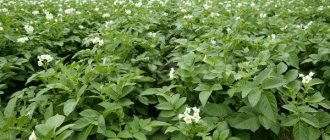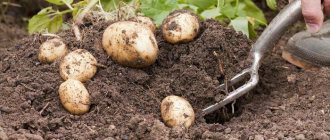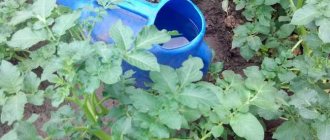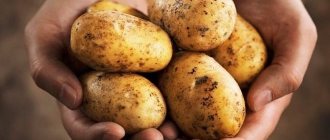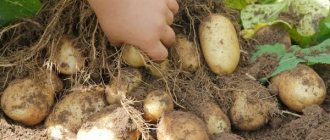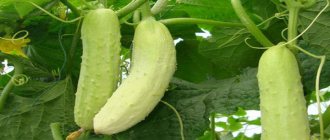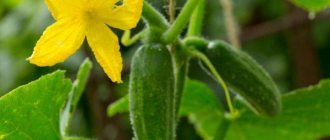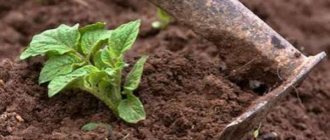Potato variety Sorokodnevka description
- medium-sized tubers, weighing from 80 to 120 g;
- oval or round-oval shape;
- the peel is thin, evenly colored, smooth or slightly rough;
- the color of the peel is light, from white to pale yellow or pinkish;
- eyes small, shallow, uncolored;
- the pulp is creamy or pale yellow when cut;
- the starch content is moderate, ranging from 11 to 15%;
- high content of protein, valuable amino acids, beta-carotene.
General information about culture
Potatoes 40 days old Spring were bred by specialists from the Leningrad Research Institute of Agriculture. Included in the State Register of the Russian Federation in 1994. This culture is widespread in Moldova, Ukraine, and Belarus. The Vesna variety is also zoned in the Far Eastern, Ural, Volga-Vyatka and Siberian regions of Russia. The purpose of potatoes is table food. It is successfully grown by gardeners both for their own consumption and for sale. Since the root vegetable has a low starch content, it is suitable for preparing a variety of dishes.
Appearance of the variety
Vegetable growers cultivate 2 varieties of this very early variety, which differ slightly from each other in morphological characteristics: Spring Pink and Spring White.
Characteristics of potatoes
Potato Sorokodnevka is a common name for especially early varieties.
Most often, folk selection varieties , which are quite difficult to identify within the State Register.
Potatoes are suitable for growing on small farms and in household plots; they are not used for industrial cultivation.
Ultra varieties are tolerant of weather changes ; they tolerate light frosts and not very fertile soils. Able to tolerate short-term drought.
In regions with warm climates, Sorokodnevka is planted 2 or even 3 times a year . The yield is good; depending on the composition of the soil and climate, from 200 to 300 centners of potatoes can be harvested from 1 hectare.
The composition of the tubers is uneven; along with large root crops, small non-marketable items are found. There are few ugly tubers.
The bushes are medium-sized or tall, quite spreading. Abundant formation of green mass, medium-sized leaves, dark green, with slightly wavy edges. The corolla is made up of large white, rapidly falling flowers. Berries are rarely set.
Sorokodnevka potatoes are poorly stored and cannot be transported over long distances . But it is great for sale. Early beautiful tubers are in good demand and allow you to quickly sell the harvest.
You can also get acquainted with other early-ripening potato varieties presented on our website: Borovichok, Kubanka, Crimean Rose, Krepysh, Felox, Triumph, Agata, Gollandka, Natasha, Red Lady, Scarlet, Uladar, Bullfinch, Rosara, Bullfinch, Red Scarlett, Molly, Luck, Lyubava, Latona.
Early ripening protects potatoes from many unpleasant nightshade diseases. It is rarely affected by potato cancer or common scab, and is resistant to viruses. It is practically not affected by late blight of leaves and tubers.
The taste of potatoes is pleasant , but not too strong. Magpie is not watery or dry; its moderate starch content prevents the root vegetables from darkening during cutting and cooking.
Cookability is moderate. The best use of tubers is cooking boiled whole potatoes, baking, stuffing, deep-frying.
How to care for plantings
Caring for the Sorokodnevka potato is simple; it requires timely watering, hilling, fertilizing, and loosening. Bushes should be periodically treated against diseases, beetles, and insecticides.
Watering and fertilizing
Sorokodnevka potatoes do not need frequent watering, especially during the rainy season. If the drought continues for a long time, irrigate the plants 2 times a month. After planting, it is better to cover the bushes with cling film overnight. This will protect them from sudden frosts.
Dilute 0.5 kg of mullein in 10 liters of warm water, adding 15-20 g of crystalline urea. To prepare a nutritional combination from bird droppings, take 1 tbsp. dry organic matter, dissolves in 10 liters of water. The second feeding is carried out during flowering, adding a solution of 15 g of potassium sulfate with the same amount of superphosphate, which is dissolved in 10 liters of water, under the bushes.
Loosening and mulching beds
You should weed the bushes 2 times a week, carefully plowing the soil to the floor of a shovel.
It is important to remove weeds that interfere with the normal development of Sorokodnevka potatoes. Mulch the beds with peat, hay, and sawdust to conserve moisture, heat, and prevent beetle attacks and diseases.
Hilling
Potatoes are hilled when 5-6 leaves appear on the shoots. The second procedure is done 2 weeks after the first. If you ignore the event, the tops will get tangled due to insufficient space. This makes the process of caring for and harvesting problematic.
Diseases, pests: control and prevention
Sorokodnevka potatoes are famous for their high resistance to cancer, nematode, scab, and viral pathologies. Adequate prevention of the above diseases is ensured even during planting, healthy tubers are selected, and fertilizers are applied to the hole. Sometimes vegetables are attacked by beetles, especially in the absence of proper care.
Young potato bushes Sorokodnevka are exposed to the following insects.
- Aphid. Small bugs settle in colonies on the lower part of the leaves. They release toxins and the plant changes shape. The foliage curls, the buds dry out, the flowers become curly and do not form fruit. The leaves are covered with mesh or yellowish spots, become dirty, and do not receive enough sunlight. Aphids provoke infection of potatoes with sooty fungus. The sprouts weaken and freeze. Sometimes aphids form tumors and ulcerative lesions on the bushes. The pest is a carrier of many viruses. Destroy it with a soap solution - 100 g per 10 liters of water. Aphids are often removed with insecticides such as Confidor, Aktara, Aktellika.
- Wireworm. The insect feeds on plant rhizomes and gnaws long tunnels in tubers. The beetle appears on potatoes immediately after planting, penetrating deep into the root crop, gnawing through the skin. Traces like holes remain on the fruits; they rot from the inside. Due to the attack of potatoes by wireworm, you can lose the entire crop. It is necessary to destroy the pest using crushed eggshells, which are scattered on the ground where the bushes grow. You can also water a solution of potassium permanganate at the root of the plant - 2-4 g per 10 liters of water. Among the insecticides, Barguzin and Pochin are distinguished. As a preventative measure, place birdhouses next to potato bushes. Birds destroy wireworms.
- Colorado beetle. At the end of May, these pests can be found on bushes, usually after warming. Insects are removed by hand, the plants are sprayed with Anti-Colorado, Taboo, Apache, Lightning, Calypso. 2 weeks before harvesting, bushes cannot be treated with chemicals.
Timely weeding and the application of ammonium nitrate and nitrogen prevent the appearance of pests on potatoes. Severely affected plants are burned to kill all larvae.
Photo
The photo shows the Sorokodnevka potato variety:
Advantages and disadvantages
Among the main advantages of the variety:
- very early maturation;
- pleasant taste of tubers;
- good yield;
- unpretentiousness;
- tolerance to drought, low temperature, heat;
- versatility of tubers;
- seed material does not degenerate for a long time;
- resistance to major diseases.
Despite a lot of advantages, the variety also has disadvantages . Collected tubers are very poorly stored ; they are recommended to be consumed immediately after digging. Due to the thin skin, root crops can be damaged when digging, so harvesting is carried out only by hand .
Features of cultivation
Many beginning gardeners have a question: when to plant Sorokodnevka potatoes? It is planted in the spring , the soil should warm up to 10 degrees, but retain a good supply of moisture.
In regions with a warm climate, planting is possible at the end of March, but more often the tubers are planted closer to the beginning of May . After digging up the first crop, the soil is loosened, fertilizers are applied and a second batch of tubers is planted.
Thus, up to 2-3 harvests can be obtained per year . Gardeners note that the second time they are planted, the tubers turn out to be larger.
Before planting, the tubers are pickled, dried, and treated with a growth stimulator. For planting, use intact medium-sized potatoes. Non-marketable small items do not guarantee productivity; large root crops cannot be obtained.
The bushes are planted at a distance of 30-35 cm from each other. Before planting, you can add a little humus and wood ash to the holes. During the planting season, they hill up 1-2 times, forming high ridges.
It is not necessary to water the plantings ; the spring soil retains a sufficient supply of moisture. There is no need to fertilize the bushes ; a single feeding before planting the tubers is enough.
Before planting, you should determine how many potatoes you will need. Root crops store very poorly; it is advisable to eat them immediately after planting. Only the seed material needs to be stored, and it will have to be sorted out frequently to reject damaged tubers.
June - blow into the bins
At the beginning of June, our potatoes will cover the entire bed allocated for them with a lush tent of foliage and stems. Now she is no longer afraid of any weeds or parasites. We patiently wait another 8-10 days and set off with a basket for the first harvest.
As we have already mentioned, forty days old is not suitable for long-term storage, during which it significantly loses its culinary qualities. Its main value is the young bulbs, not covered with thick skin. First of all, we count out several bushes of early potatoes, which we will not touch until the tubers are fully ripened - they will be useful to us next year as planting material.
In June, the forty-day period is not afraid of either weeds or weather (Illustration source: chudo-ogorod.ru)
How to collect forty days? Very simple. Since we are not going to wait for the peel to harden, we grab the bush by the tops and tear it out by the roots. Some of the tubers, naturally, will remain in the ground, so we dig the soil with a two-horned hoe or rake it with our hands. We collect the bulbs, tearing off the remaining roots from them, put them in a basket (bucket, bowl, bag) and run to the kitchen in anticipation of a delicious lunch.
It is fashionable to use another, more sophisticated method of harvesting. We carefully dig up the soil around the potato bush with our hands, trying to feel the large bulbs. We select them from the soil, leaving the plant untouched. With this method, the potatoes will still have time to grow a mass of small tubers.
We use the young potato harvest of forty days for food until mid-July. From the moment the tops begin to dry out (the second half of July), the skin on the tubers will begin to thicken and they will partially lose their delicacy value. Try to use the forty-day period as much as possible, leaving until full ripening only those bushes whose harvest is intended for obtaining planting material.
Since new potatoes are not intended for long-term storage, try to use them as needed. An important point: the fresher the new potatoes, the easier it is to peel off the films (thin, translucent husks). When stored for several days, tubers removed from the soil wither and rot.
The fortieth day will ripen in June (Illustration source: www.intermonitor.ru)
Diseases and pests
The Sorokodnevka potato is resistant to many nightshade diseases . It is rarely affected by potato canker, golden nematode, scab or viruses.
Early ripening prevents plants from becoming infected with late blight.
For prevention, tubers are treated before planting; it is recommended to change planting areas annually.
This strategy will not only protect potatoes from diseases, but will also significantly increase yields.
Young fresh tops attract a variety of pests: aphids, Colorado potato beetles, spider mites, wireworms, and cicadas. Timely weeding and pre-planting treatment of soil and tubers will help protect the plantings.
Before planting, it is important to select plant remains from the soil, which can become a breeding ground for insect larvae.
In case of severe lesions, spraying with insecticides is possible. It is advisable not to carry out treatment after the bushes begin to flower.
Chemical preparations will help in the fight against the Colorado potato beetle: Aktara, Corado, Regent, Commander, Prestige, Lightning, Tanrek, Apache, Taboo.
The Sorokodnevka potato variety is a real favorite in private farms. Potatoes ripen quickly, suffer little illness, and the tubers have a pleasant taste and beautiful appearance.
Despite the lack of official registration, the variety continues its victorious march through private gardens, delighting lovers of healthy early potatoes.
July – the beauty of summer, the middle of color
In the second half of July, the remaining forty days should be removed from the garden. By that time, the potato tops will have already dried out, and the bulbs will have formed a dense skin. We cut off the above-ground part of the plants, leave the bed alone for 5-6 days and dig the potatoes out of the ground. We carefully dry the planting material, sort it and send it for storage in a dry, well-ventilated room. And in the spring we plant them in the garden again.
Unfortunately, the forty-day period pleases us with a fresh harvest for only 1 month. But this also has its advantages. Firstly, already in June you will enjoy the mind-blowing taste of new potatoes, and secondly, after forty days you will still have time to grow a late harvest of dill or parsley in that same garden bed. So, don't despair. Moreover, by the end of July, beginning of August, both medium and late-ripening potato varieties will delight you with young potatoes.
Plavinsky N.K.
Transformable furniture: choice for a small apartment
